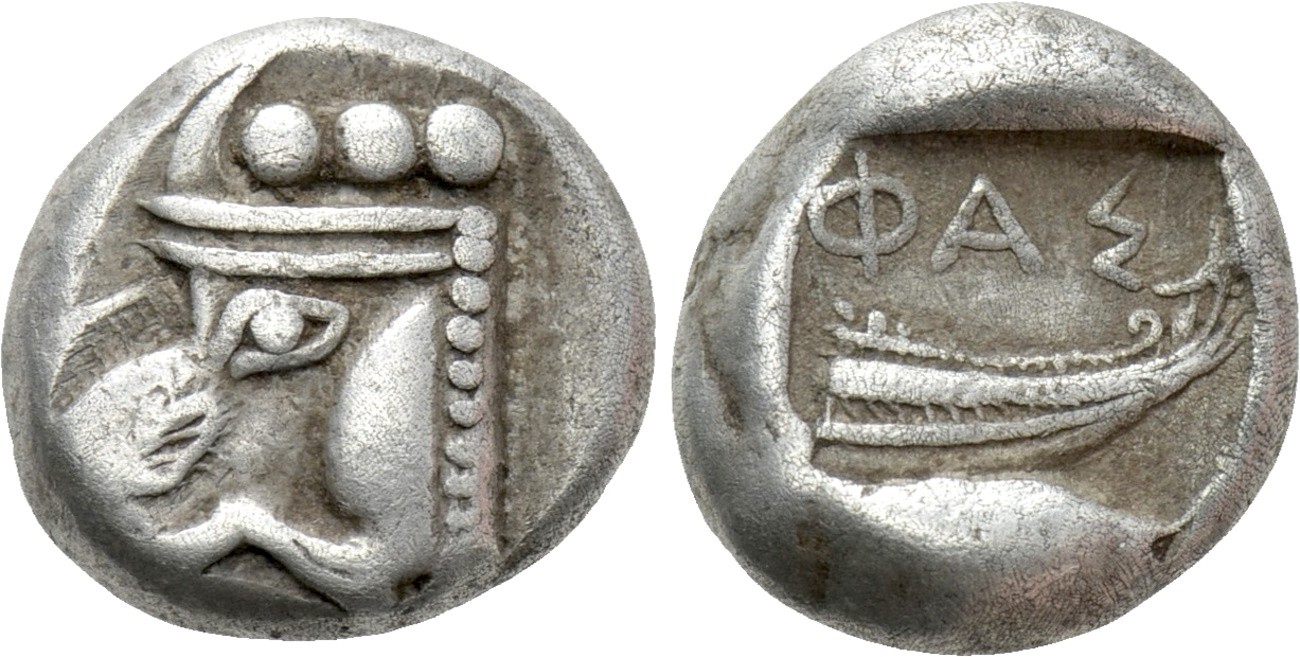Phaselis, silver, double sigloi (400-330 BCE)
From SILVER
m (Callatay moved page AC 262a - Phaselis, silver, stater to AC 262a - Phaselis, silver, staters (500-440 BCE)) |
Bilgischer (talk | contribs) |
||
| Line 1: | Line 1: | ||
{{Die Study | {{Die Study | ||
| + | |Image=AC262a Phaselis.jpeg | ||
| + | |Image reference=https://www.acsearch.info/search.html?id=7214746 | ||
| + | |Obverse description=Prow of galley left in the form of forepart of boar. | ||
| + | |Reverse legend=ΦΑΣ | ||
| + | |Reverse legend language=Greek | ||
| + | |Reverse description=Stern of galley right within incuse square. | ||
|Mint=Phaselis | |Mint=Phaselis | ||
|Ancient region=Lycia | |Ancient region=Lycia | ||
| Line 10: | Line 16: | ||
|RQEM reference=RQMAC | |RQEM reference=RQMAC | ||
|RQEM reference number=262a | |RQEM reference number=262a | ||
| − | |Die study reference= | + | |Die study reference=Heipp-Tamer 1993, n° 74-5. |
|Coin series reference=Sear II, n° 5331; RQEMAC, n° 262a | |Coin series reference=Sear II, n° 5331; RQEMAC, n° 262a | ||
| + | |Coin series web reference=https://greekcoinage.org/iris/id/phaselis_heipp-tamer_1993_4 | ||
|Number of obverse dies=2 | |Number of obverse dies=2 | ||
|Number of reverse dies=2 | |Number of reverse dies=2 | ||
|Number of coins=2 | |Number of coins=2 | ||
}} | }} | ||
Revision as of 10:39, 23 May 2023
500 BCE - 440 BCE Silver 24,236 kg
Description
| ObverseInscription or printing placed on the obverse.: | Prow of galley left in the form of forepart of boar. |
| ReverseInscription or printing placed on the reverse.: | ΦΑΣ (Greek).Stern of galley right within incuse square. |
Mint and issuing power
| MintIdentifies the place of manufacture or issue of a numismatic object.: | Phaselis | Ancient regionAncient region.: | Lycia | Modern countryModern country: Turkey | AuthorityIdentifies the issuing power. The authority can be "pretended" when the name or the portrait of X is on the coin but he/she was not the issuing power. It can also be "uncertain" when there is no mention of X on the coin but he/she was the issuing power according to the historical sources: |
Chronology
| FromIdentifies the initial date in a range assigned in a numismatic context. | 500 BCE | toIdentifies the final date in a range assigned in a numismatic context.. | 440 BCE | PeriodTime period of the numismatic object.: Classical 480-323 BC |
Physical description
| MetalThe physical material (usually metal) from which an object is made.: | Silver |
Median weightMedian of the weights of numismatic objects (in grams). in grams | 11.00 | DenominationTerm indicating the value of a numismatic object. Examples: tetradrachm, chalkous, denarius.: | stater |
StandardStandard.: |
Image

AC262a Phaselis.jpeg [1]
References
| Die study referencePublication of the study: | Heipp-Tamer 19931Heipp-Tamer 1993, n° 74-5. | ||
| Coin series referenceReference to coin series study: | Sear II2Sear II, n° 5331, RQEMAC3RQEMAC, n° 262a | ||
| Coin series web referenceCoin series web references: | |||
Obverse dies distribution
| FrequencyFrequency of specimen in distribution. ᵖ | Number of obversesNumber of obverse dies. ᵖ (o) | % (o) | Number of coinsNumber of coins. (n) | % (n) | Die nameName(s) of the die(s). |
| 1 | 2 | 100 | 2 | 100 | 49, 50 |
| Total | 2 of 2 | 100 | 2 of 2 | 100 |
Reverse dies distribution
no distribution is available
Quantification
| Number of obversesNumber of obverse dies. ᵖ (o) | 2 | Number of singletons (o1)The number of singleton coins. ᵖ | |
| Number of reverse diesNumber of reverse dies. (r) | 2 | Number of coinsNumber of coins. (n) | 2 |
| Coins per obverse dieNumber of coins per obverse die. (n/o) | 1 | Coins per reverse dieNumber of coins per reverse die. (n/r) | 1 |
| Reverse per obverse ratioRatio of obverse dies divided by reverse dies. (r/o) | 1 | Percentage of singletons (o1)number of coins (n) divided by the number of singletons (o1) ᵖ | % |
| Original number of dies (O) (Carter 1983 formula)The estimation of the number of coins according to Carter 1983 ᵖ | 117.65 | Coins struck if 20,000 as average productivity per dieCoins made if the average productivity for obverses (according to Carter) is 20,000. ᵖ | 2,353,000 |
| Original number of dies (O) (Esty 2011 formula)The estimation of the number of coins according to the singleton formula in Esty 2011 ᵖ (O) | Survival rate if 20,000 as average productivity per dieSurvival rate if average productivity is 20,000. ᵖ | 0.00000 | |
| Coverage (o = % of O) (Esty 1984 formula)Esty 1984 - coverage (% of O) ᵖ (o = % of O) | % | Die productivity if survival rate 1/2,000Average productivity if survival rate is 1/2,000. ᵖ | 34 |
| Weight of silver (in kg) if 20,000 coins per die (O = Carter formula)Carter 1983 * Median weight * 20000 (*10 if gold or electrum) ᵖ | 25,883 kg <br /> 24,236 kg | Die productivity if survival rate 1/5,000Average productivity if survival rate is 1/5,000. ᵖ | 85 |
Remarks
References
- ^ Heipp-Tamer, Christine (1993), Die Münzprägung der lykischen Stadt Phaselis in griechischer Zeit, Saarbrücken, 182 p., 32 pl.
- ^ Sear, David R. (1979), Greek coins and their values. Vol. II, Asia and North Africa, London, xlviii, p. 317-762
- ^ Callataÿ, François de (2003), Recueil quantitatif des émissions monétaires archaïques et classiques, Numismatique Romaine, Wetteren, VII + 267 p.